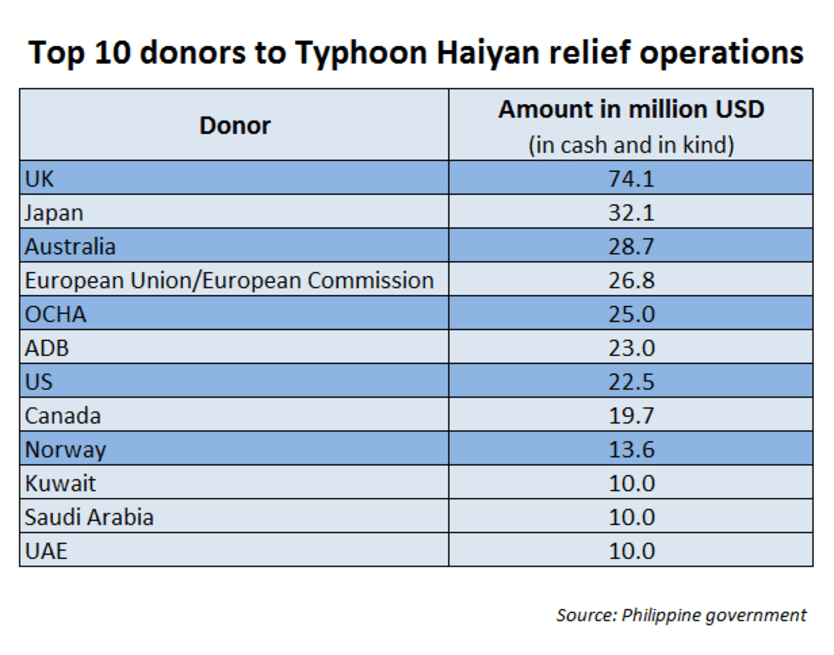
Following a throng of controversies regarding public funds management, the Philippine government is now trying to restore people’s faith by being transparent on how both local and international aid for the victims of Super Typhoon Haiyan is being used.
The administration last week launched the Foreign Aid Transparency Hub for transparency, accountability and, according to a senior budget official, to put integrity back in the process.
“[FAiTH] builds credibility and integrity in the governance of aid,” Undersecretary for Budget and Management Richard Bon Moya told Devex. “At the core of it, it improves the integrity of the whole process and, therefore, people do not become cynical when they give aid.”
The country’s legislative branch have been under intense scrutiny following a scandal linking several well-known lawmakers to embezzlement of huge amounts of public money through a massive corruption scheme. This pushed the public to become more engaged and demand tighter scrutiny over how development funds are disbursed, especially during this moment of national calamity.
Through the online transparency portal, the public can now examine under careful eyes the amount given to the country by donors for post-disaster relief and rehabilitation. As of posting time, the amount topped 15 billion pesos (almost $344 million) in donations and pledges, both cash and in-kind, by local groups, around 30 donor countries and countless humanitarian groups around the world.
Although more action is needed to fully ensure that the money is being spent effectively and efficiently, being transparent about the amount and where the money comes from is a necessary first step in holding everyone accountable in the Philippines, traditionally plagued by endemic corruption.
Transparency and accountability
Two of the main reasons why the government pushed for this initiative is to open up the governance and expenditure process to the people and engage them in a truly democratic way. Moya said it’s not only being honest with the donors and the people, but it also holds everyone accountable.
“It assures the public that we are tracking the pledges being made and then making it transparent. Ultimately, we want to account for each and every peso that passes through government so the citizens can be assured and the donors as well,” he explained while adding the urgency was due to the public’s clamor for transparency.
FAiTH is mandated by Philippine President Benigno Aquino III, who swept to power in 2010 on a self-proclaimed crusade to fight corruption and enforce accountability. Analysts suggest things are slowly improving under his leadership, but the road remains long and winding.
“[Transparency] is important in many levels. For country donors, transparency holds the governments accountable to their taxpayers. Same goes with multilateral agencies. We can hold those who have pledged accountable [because before] there’s no mechanism for them to [ensure they will] actually deliver,” Moya said. “It doesn’t look nice if we keep asking for money when something happens and yet those donors cannot see the results of their charity to the intended beneficiaries.”
Long-term mechanism
Asked whether the transparency thrust will remain even after the culmination of the relief and rehabilitation in Haiyan-ravaged areas, Moya said it will. But in the meantime, the focus will be on the most recent natural calamity.
“The answer is it’s [for the] long-term. But for now, it’s just a couple of weeks [after the typhoon] and we’re just tracking the flow and expenditure of money. But we are getting information that we will backtrack and include the Bohol and Zamboanga relief efforts, among others,” he noted.
With scientists and weather experts firm in saying that storms like Haiyan are just the prelude of stronger and more devastating typhoons in the future, the call for better disaster preparation and risk reduction efforts is stronger than ever. These efforts will entail substantial funding, and for the government, having a systematic and organized structure on how to funnel these funds to sustainable climate-focused efforts will be crucial.
“It’s a systematic approach because we want to establish systems and protocols so that moving forward, as we expect more disasters to come in, we have a better mechanism to account for all these funds,” Moya concluded. “We are looking to make this a permanent fixture to publish foreign aid-related efforts.”
Here’s a list of the top 10 donors as of Nov. 25:

Read more development aid news online, and subscribe to The Development Newswire to receive top international development headlines from the world’s leading donors, news sources and opinion leaders — emailed to you FREE every business day.
See more:
